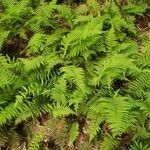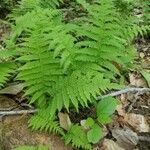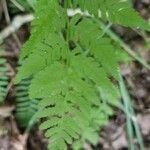Rhizome with a few pale, appressed, lance-ovate scales, otherwise glabrous; lvs to 9 dm, the petiole dark and scaly at the base, sparsely hairy, 12–20 cm, much shorter than the blade; blade narrowly lance-elliptic, acuminate, to 15 cm wide, pinnate-pinnatifid, gradually narrowed below, the lower pinnae reduced to mere rudiments; pinnae many pairs, sessile, lance-linear, to 15 mm wide, with linear-oblong, obtusish, subentire segments; rachis, costa, and veins hairy, without scales; veins simple or rarely a few forked; indusia pale, long-ciliate; 2n=54. Mixed woods and swamp-margins; Nf. to Ont. and se. Wis., s. to Ga., Ala., and Ark. (Aspidium n.; Dryopteris n.)




